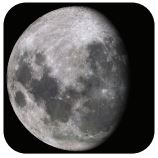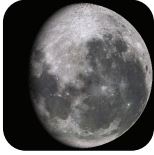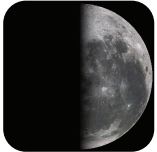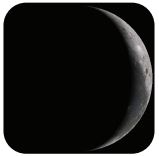The most obvious change we see in our view of any celestial object is the sequence of phases of the Moon.
Over a period averaging 29.53 days, the Moon appears to run through its cycle of apparent shapes (phases), but it is not actually changing its shape at all. We see the Moon because the Sun shines on it.
The different phases are seen because the Moon is moving around the Earth, so we see the Moon in different directions as it moves. When the Moon is in the opposite direction to the Sun (rising in the east as the Sun sets in the west), we see the Moon fully illuminated by the Sun.
As another example, about a week earlier, the Sun was shining onto the Moon from the side (as seen from here), so only half of the Moon appeared in sunlight, making it look like an uppercase letter ‘D’ (inverted, from the southern hemisphere).
There is a misconception that the phases of the Moon are caused by the shadow of Earth falling onto it. However, that effect is quite different, and it happens only during an eclipse of the Moon.
The sequence phases
 |
Waxing crescent |
 |
First quarter |

|
Waxing gibbous |

|
Full moon |

|
Waning gibbous |

|
Last quarter |

|
Waning crescent |
Images: Phases of the Moon as seen from the southern hemisphere from just after new moon to just before the next new moon. Its position at each point is shown on the next page.
Between these ‘main’ phases, the Moon appears as either a crescent shape (less than half full) or a gibbous shape (more than half full).
We use the term ‘waxing’ for phases before full moon, and ‘waning’ for phases after full moon.
The Moon’s orbit is seen looking north from a point to the south of the Earth and Moon. From there, the Moon orbits clockwise. The orbit is slightly oval-shaped, which is not shown in this simple diagram.
The side opposite the visible side is called the far side of the Moon. This is sometimes mistakenly called the dark side, but there is no permanent dark side of the Moon.
Because the Moon rotates, each part of the Moon experiences alternating dark and light periods (lunar ‘day and night’) over each 29.53-day period, just as Earth does over each 24-hour period.
The entire cycle of phases lasts 29.53 days, on average, which is just over two days more than the Moon’s actual period of revolution around Earth (27.32 days).
This is because Earth (and the Moon) move around the Sun, so the Moon takes just over two extra days to return to the same position in relation to the Earth and the Sun.
As you observe the Moon through its range of phases, you will see that the same side of the Moon always points toward us. The dark markings on the Moon, which are lava flows that occurred long ago, remain in the same positions on the Moon’s disc.
This is sometimes mistakenly interpreted as meaning that Moon does not rotate. However, it does rotate, in the same amount of time that it takes to orbit Earth (27.32 days).
The effect is called synchronous rotation, and is quite common amongst the planetary satellites. To be more exact, there is a tiny wobble in the Moon, and a much larger apparent wobble because of the slightly changing angles at which we view it. Mostly because of the latter, about 59% of it is visible from Earth at one time or other
Demonstrating the phases at home
It is easy to demonstrate how the phases of the Moon arise by using a light and a ball. The light represents the Sun and the ball represents the Moon. By holding the ball in different positions in relation to the observer, it will show phases just like the Moon!
When the Moon appears as a crescent, in the evening sky just after new moon or in the morning sky just before new moon, we can often see the rest of the Moon shining faintly, as in the illustration.
This may seem odd, because there is no direct sunlight falling onto that part of the Moon. However, there is light there: it is reflected light from Earth. This is why we call it ‘earthshine’.
At these times, an observer on the Moon would see a nearly full Earth in the sky, shining very brightly.
So, just as we can see the ground at night when the Moon is bright, astronauts on the Moon would be able to see to walk around (carefully!) using light from Earth.
The effect is clearly visible only when the Moon’s phase is small, for two reasons. Firstly, this is when Earth is brightest in the lunar sky.
Secondly, as the part of the Moon illuminated directly by the Sun appears larger, it also appears brighter and makes the earthshine harder to see. A better view of earthshine can be obtained by using a pair of binoculars.
'Wrong' views of the moon
Errors are often made during attempts to depict the Moon correctly. The most common mistake is to show the Moon upside down in movies! It does appear the other way up from the northern hemisphere, including the orientation of its phases.
However, errors probably arise because moviemakers are unaware that there is a difference. In some cases, footage of the Moon made in another part of the world was used as the backdrop to their movie scene.
Another error is to show the Moon reversed left for right, as seen in a mirror. This mistake is harder to explain, but may be because ‘artistic licence’ has been used inappropriately.